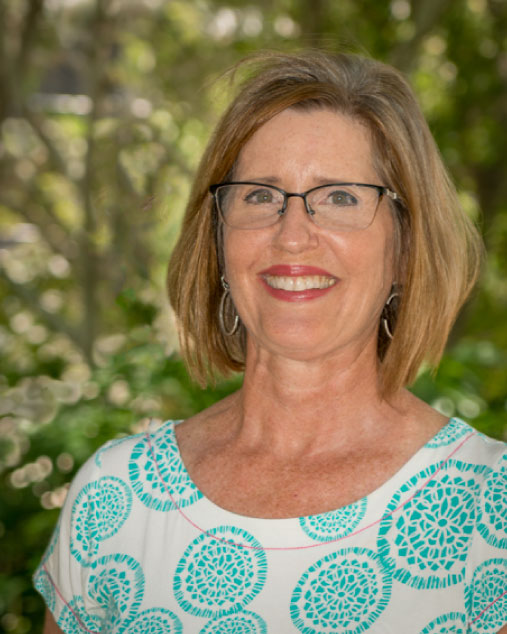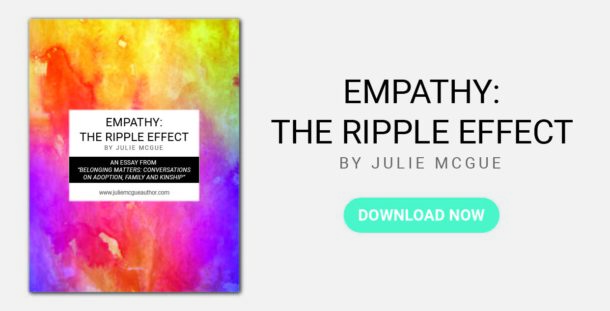Another Look at
Secondary Rejection

Julie McGue
Author
Several weeks ago, I wrote about secondary rejection–a term which refers to the disappointment and hurt that birth relatives experience when they try to connect with the family they lost to adoption. I shared in my previous post how bumpy the reunion road became between my birth mom and me. And how, eventually, I confronted my birth mom about her behavior, and we ironed out our issues.
With all this negative energy successfully shelved, I was caught off guard last fall by a fresh wave of secondary rejections. My stepdad, my birth mom’s husband, had slipped and fallen in the bathroom. He’d broken several bones and gashed his head. I found out about this mishap, not from my birth mom, but by email from a first cousin with whom I’ve become friendly.
As you can imagine, I stewed about why my birth mom did not communicate with my twin sister and me about our stepdad’s accident. When I summoned the right energy and reached out to my birth mother, she was so distraught about her husband that I chose not to confront her. I closed our conversation by requesting that she keep me updated on his progress. A week later, another email from my cousin landed in my inbox. This time, she expressed her condolences regarding my stepdad’s sudden death.
My heart sank on two counts.
First, I mourned my stepfather, a man whose kindness and easy acceptance of me when I entered his world ten years ago had met no parallel. And then, I grieved over the secondary rejection. Once again, my birth mom had deliberately left my sister and me out of the communication loop. I felt rejected, hurt, angry, and sorrowful.
When I opened that second email from my cousin, I was enjoying dinner with my son, his fiancé, and her parents. The five of us had spent the day finalizing their wedding plans for April 2022. After I shared the shocking news of my stepdad’s passing, my son enveloped me in a hug.
“I’m sorry, Mom,” he said. “About your stepdad. And how you heard about it.”
When my future daughter-in-law drew me into a comforting squeeze, I realized I was right where I needed to be. I was among family who cared about me, loved ones who treated me with dignity and respect, and people who acknowledged that the rejection tearing up my insides was both valid and warranted.
I invoked the twenty-four-hour rule of caution and waited to phone my birth mom. The next morning, I opened our conversation by expressing my sympathies. She grew defensive as she explained that my presence at his funeral would complicate her life. I held my breath as she rattled on. I learned that because my stepdad’s relatives were scattered over a three-state area, she had never seen the merit in informing them about the twin daughters she had placed for adoption and who had recently come back into her life.
When I got off the phone with my eighty-eight-year-old birth mom, a woman who was once an unwed mother and was now grieving a different kind of loss, I sighed. The situation wasn’t a deliberate rejection. Rather, it was about her attempt to control the emotional pain surrounding his funeral. She was grieving. Incorporating the unveiling of her past “sin” to unknowing relatives was more than she could take on. Sympathy edged out the hurt consuming my heart. Reluctantly, I had agreed to stay home and grieve privately.
A modern birth mom, one who experiences more transparency in her adoption plan, might have elected to surround herself with her only daughters so that they could all share in the grieving process. Sadly, my mother is from an older generation who was subjected to a strict moral code and experienced intense social scrutiny and judgement. I realized that her habits and attitudes are deep-rooted and not easily discarded.
While secondary rejections are tough to receive, the behaviors that produce them are not always meant to be harmful. Often the root of the problem is the fear of a secret’s exposure, and a desire to preserve one’s public image at all costs. Secondary rejections are a result of an individual’s attempt to control and manage the stressors inherent in the adoption search and reunion equation.
As adoptees and birth parents enter reunion with family lost through adoption, we need to remember that there is only one aspect of secondary rejection that we can control: our reaction to it. We can choose to set boundaries for what we can or will not tolerate; we can select from a vast array of professional support; we can choose to withdraw from any relationship or setting which endangers our sense of self; and we can surround ourselves with people who treat us with the love and respect that we both crave and deserve.
And ultimately, to keep ourselves whole in the relationships we seek to foster, we are faced with a quandary: to accept, to forgive, or to move on. In the end, love and selfcare must be the guiding principles.
“As adoptees and birth parents enter reunion with family lost through adoption, we need to remember that there is only one aspect of secondary rejection that we can control“
Don’t miss a blog post!
Receive my blog posts directly to your inbox.



I really liked this…